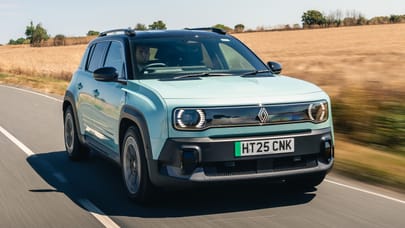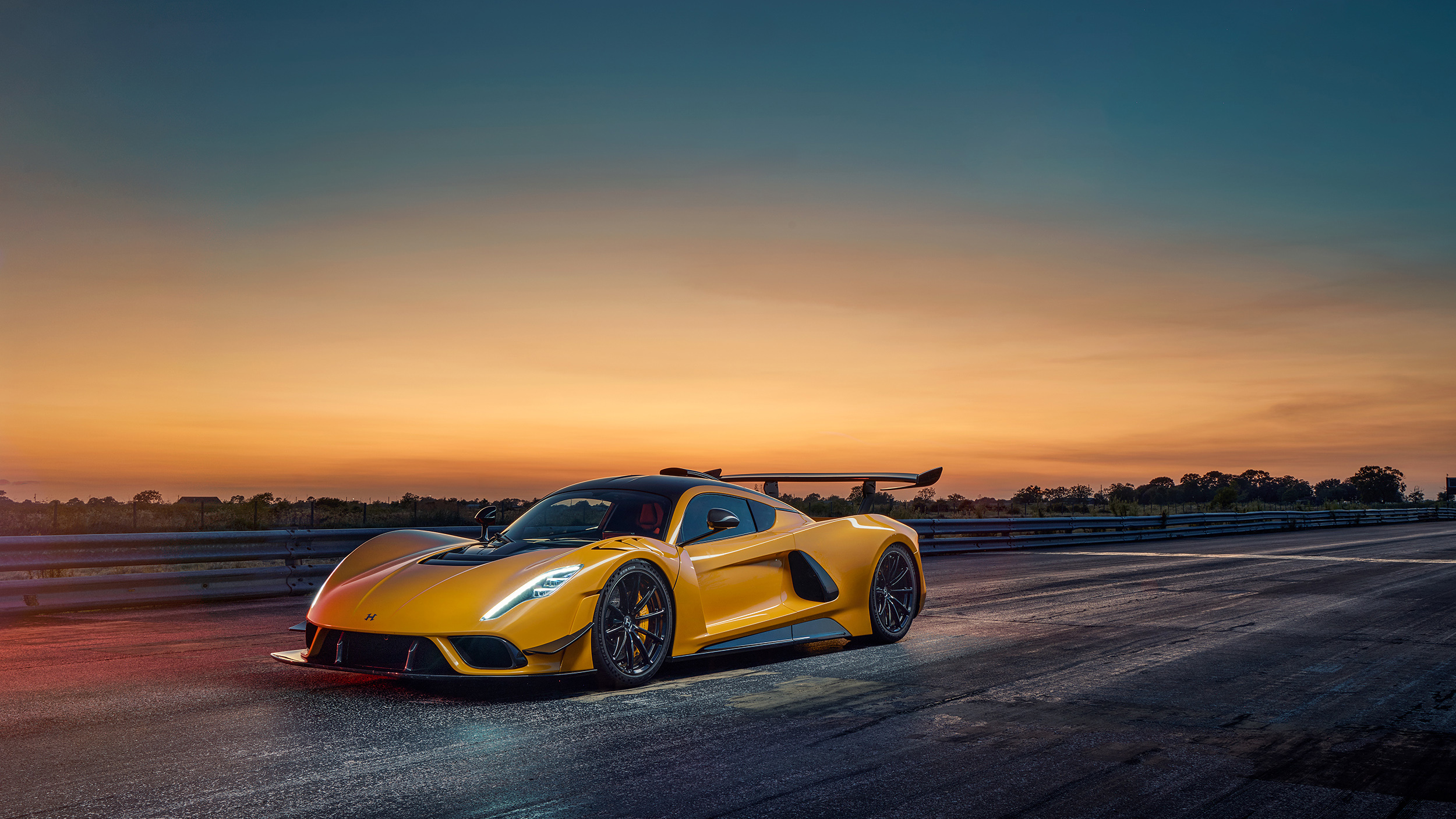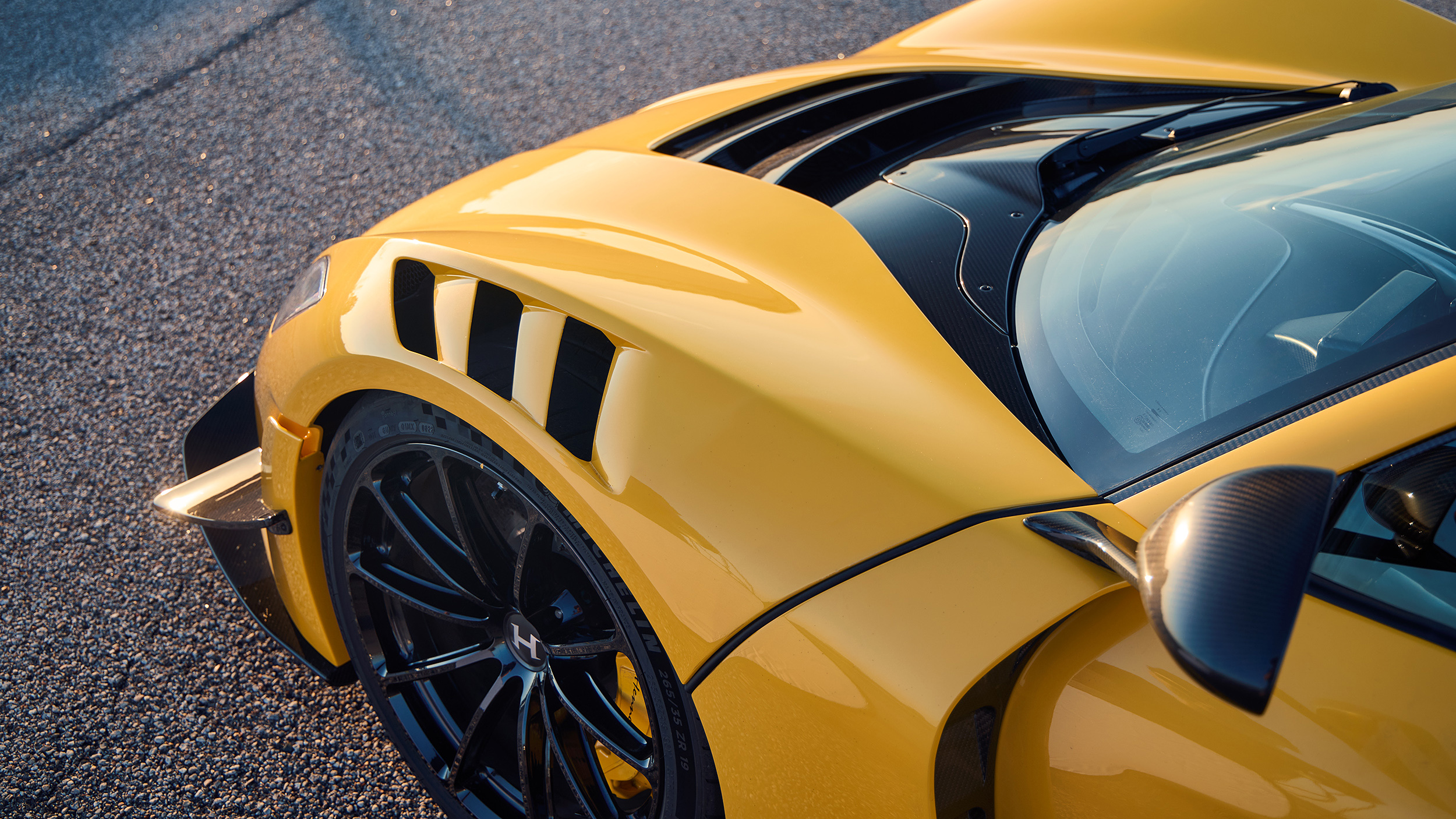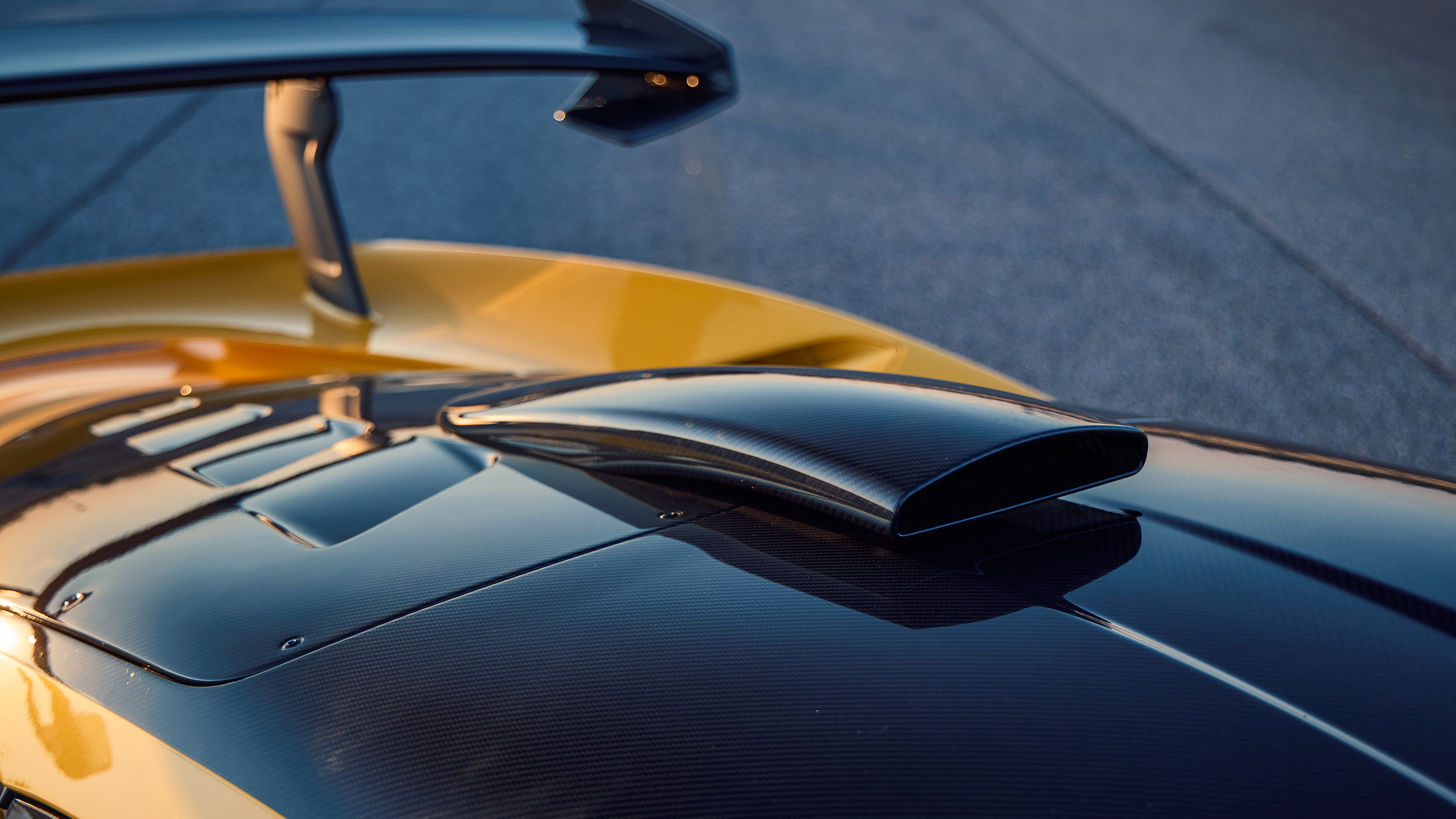
Hennessey F5 Venom Revolution Evo review: raw, wild and addictive
What on earth is that?
This is Hennessey F5 Venom Revolution Evo. Big name, with big power attached to it. F5 is the highest designation on the Fujita Scale for tornadoes; it’s reserved for the devastating, sweep-away-all-before-them kind with wind speeds measuring up to 318mph. The Revolution Evo generates up to 2,031bhp purely from a heavily turbocharged 6.6-litre V8 engine, ensuring it more than justifies the dramatic billing.
A highly detailed upgrade over the already super-endowed F5 Venom, the Evo is the world’s most powerful internal combustion-powered road car. It produces that aforementioned 2,031bhp at 8,000rpm and 1,445lb ft at 5,200rpm on E85 fuel. Hennessey claims it can record 0-200mph in 10.3 seconds. At some point in the future the low-drag version, simply called F5 Venom Evolution, will gun to set a new outright top speed record of well over 300mph. Stupid? Of course. Irrelevant? Undoubtedly. Kind of cool though, right?
Photography: Greg Pajo
What’s its background?
For those of you wondering if the Venom is just an American-made dragster in a hypercar body, let me attempt to disavow you of that notion. Yes, Hennessey’s core business is making huge pick-ups and sedans go very fast indeed - or very slow but trailing a thick fog of tyre smoke - but the ground-up, bespoke side of the operation is doing just fine. Hennessey will build 99 F5 Venoms and has already delivered 30 units. This Revolution Evo costs from $2.75 million and the Evo package is also available as a retro-fit package for $285,000. The lower-drag model starts at $2.5m.
That success might well be founded upon a ‘Made in the USA’ patriotism, but the F5 Venom is a little more international than you might expect. For example, the carbonfibre chassis and bodywork is supplied by KS Composites near Melton Mowbray, who have worked on F1 projects and all sorts of specialised road cars from the Jaguar Project 8 to supercars they’re not allowed to talk about.
The Evolution package, which consists of revised aerodynamics, suspension and an extra 214bhp over the original F5 Venom, also benefits from the input of Multimatic aerodynamist Dr Mark Handford and Ilmor Engineering in Brixworth, Northamptonshire.
Ilmor has a storied motorsport past and its thorough overhaul of the ‘Fury’ twin-turbo V8 sees the adoption of even bigger Precision 7680 turbochargers, oval billet aluminum pistons and connecting rods, titanium exhaust valves and higher-flowing injectors. The engine is built in Northamptonshire but sounds pure Americana and permeates the F5’s very being. Sitting in a mid-engined hypercar with a carbon tub, feeling it gently rock to the beat of a V8 engine like a ‘60s muscle car, is very cool indeed.
How does it all operate?
A seven-speed, single-clutch, paddle-operated ‘box gives a distinct thunk as it engages first gear – adding to the sense that there are serious forces at work – and the F5 rolls away rather grumpily. It will tolerate low speeds just fine, so long as you have a sensitive right foot, but it’s apparent this isn’t really the Hennessey’s preferred way of going about the world. The yoke-style steering wheel has lovely, low-effort weighting but the front tyres hunt around quite a bit and the ride quality is stiff even in the standard Sport mode. The Evo features new adaptive dampers by Tractive and they’re yearning for a smooth racetrack.
First impressions are slightly overwhelming, then. Yet there’s also familiarity from the strangest source. I’m in Texas but things feel oddly 'Norfolk'. Hennessey’s first hypercar was the Venom GT and it was based on a Lotus Exige (albeit with a vastly extended footprint and a V8). The F5’s DNA is very different, but the shape of its dash and windscreen is similar and the narrow, carbon seats must be based on Lotus’s old Probax chairs.
Great claims for their comfort was made when they were fitted to the Elise and Exige, but I always found them excruciating. The F5’s are similarly tortuous for me, with the added bonus of violent acceleration to increase the pain. Obviously, customer seats can be tailored for a much better fit.
Top Gear
Newsletter
Thank you for subscribing to our newsletter. Look out for your regular round-up of news, reviews and offers in your inbox.
Get all the latest news, reviews and exclusives, direct to your inbox.
Is that where the Lotus impression ends?
Yes, though the Evo does cherish that old adage about adding lightness. Thanks to its pure ICE formula and an intensive focus on weight, it tips the scales at just 1,360kg dry. The Fury engine takes a lot of lubrication and cooling, so that figure is likely to increase quite a bit with fluids, but the power-to-weight ratio is still off the scale. For context, a Lotus Emira comes in at around 1,450kg ready to roll and we recently weighed an Aston Martin Valkyrie at 1,340kg including a full tank of fuel.
On a surprisingly twisty road just outside the little town of Fayetteville, Texas, the F5 feels light, responsive and if you swim below 5,000rpm, the performance is strong but not other-worldly. That’s a good thing. After my first foray into the upper reaches, the acceleration is so violent that it seems best reserved for a closed environment and definitely commands respect. The fact that this engine can produce 307bhp-per-litre yet has good throttle response well before the turbos are blowing hard is pretty remarkable. I almost feel relaxed.
Seriously?
The general sense of well-being is enhanced by fabulous brake feel and the surprisingly well-mannered ‘box. There’s a reason big OEMs have moved towards dual-clutch set-ups despite the weight penalty, but this CIMA ‘box hits clean and hard under full load and works well at lower speeds as long as you gently reduce pressure on the throttle as you pull for an upshift. The F5 is pretty loud and the extreme power is tangible even at low speeds, but there’s just enough sophistication to mitigate the brutal, raw energy of the experience.
How does it handle?
I’d envisaged devouring straights in the blink of an eye and then a slightly clumsy, inert feel through the turns. Instead, the F5 comes to life in the corners. The chassis settles down effectively under load and exhibits lovely balance. It carves cleanly into each curve and fades into very mild understeer mid-corner. Keep the rear tyres under load and that reassuring, secure phase then shifts, and you sense the outside rear tyre is now the critical point of balance.
You’ve got a savage-sounding hypercar right in its sweet spot and it feels so easy. All that power enabling - rather than disturbing - the car’s perfect trajectory. As the corner fades to straight, you can even push into a little bit of slip at the rear with real confidence. The Revolution might wear dive planes, a huge front splitter, new wheel arch vents and a massive rear wing in search of downforce, but at road speeds it feels progressive and surprisingly adjustable.
What about on track?
Perhaps wisely, the F5’s traction control can’t be disabled but in the default Sport mode (there are also Wet, Drag, Track and F5), the systems are nicely judged. Now I’ve got ‘just’ 1,300bhp with which to play, but the Fury motor still feels about as furious as any other engine giving its all. However, the chassis displays a softer, cuddlier side.
I can pitch the car in hard off-throttle to get the tail swinging, pick up the power and lean right into the traction control systems to hold the angle for the length of an entire gear. The F5 Venom Revolution Evo is raw and can feel like sensory overload at times, but beneath the booming power delivery there’s a fundamentally well-sorted and exploitable supercar. Explore Drag mode and a full, 2,031bhp launch control start and the Evo’s resources to throw you into the horizon feel limitless.
Don’t EV hypercars offer the same?
The sensations here are so different: less initial shock, but much more excitement, and the way the big turbos build boost and keep on swelling to the rev limit creates a feeling of exponential, supernatural power. Every time your brain starts to calibrate what’s happening, the delivery seems to ramp up further. The Fury V8’s relentless power is always a step ahead. Imagine that first freefall sensation on a rollercoaster continuing without end. That’s the F5 Venom Revolution Evo at full noise. It is wild. And addictive.
Is this a viable alternative to more blue-blooded hypercars?
Yes, with some caveats. Firstly, that headline-grabbing 2,031bhp output reduces significantly to 1,300bhp on more regular ‘pump gas’. Here in the UK there are precisely zero E85 outlets. In the US, around two per cent of stations have E85 and in Europe the picture is mixed but still relatively bleak if you want to regularly fill the heart of a 6.6-litre twin-turbocharged V8. Now, 1,300bhp is a lot. But it isn’t 2,031bhp.
Take away the ingredient of simply being the biggest hammer out there and you might start to look more closely at other hypercar attributes and wonder if the Hennessey is on the same level. The exquisite detailing of a Pagani Utopia, for example. The pure, wondrous tactility of a GMA T.50. Or the simply stunning completeness and motorsport pedigree of a Ferrari F80. The benchmarks are impossibly high.
So what’s the verdict?
Fundamentally this is a really good car that feels slightly in thrall to its massive power output. Take that away and it’s still pretty dazzling, but the compromises made to tame the full 2,031bhp start to make less sense. Ironically, if it was designed from the ground up to have 1,300bhp, I suspect it would be all the sweeter and more enjoyable on the road.
It's a killer car and a huge achievement. But now Hennessey has established itself in this rarefied air, I hope their next model isn’t quite so concerned with unheard-of power outputs and smashing the 300mph barrier and instead focuses on unleashing the very obvious potential lurking beneath. Having said that, I won’t forget firing this thing off the line in a hurry. It was Fujita-ing unbelievable.
Featured










